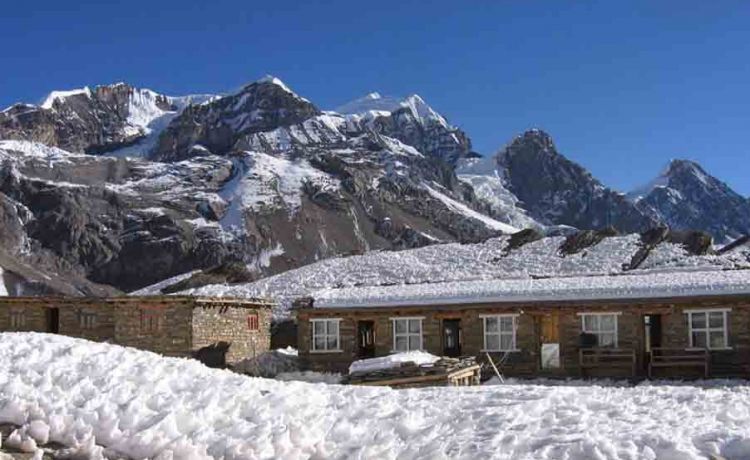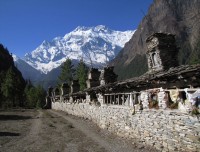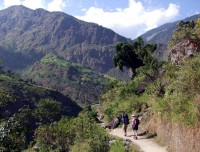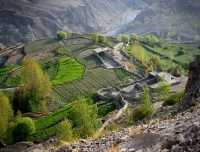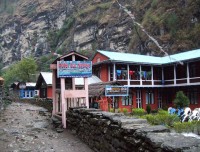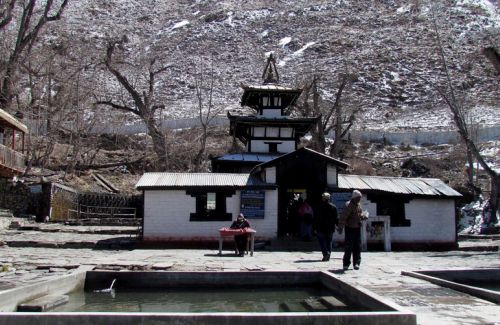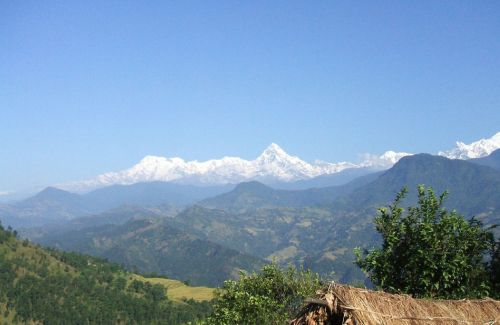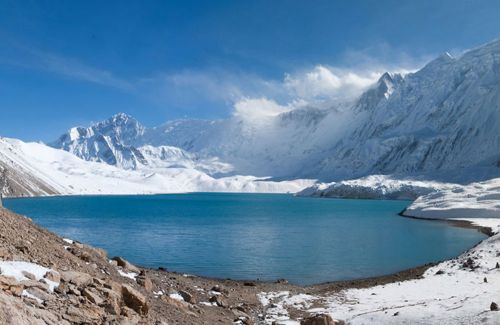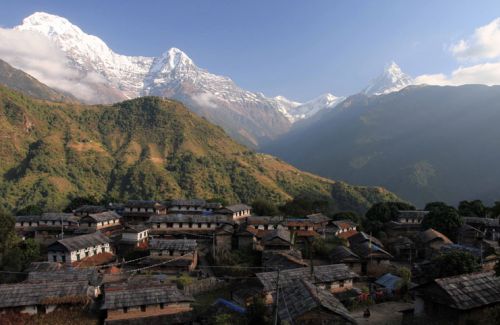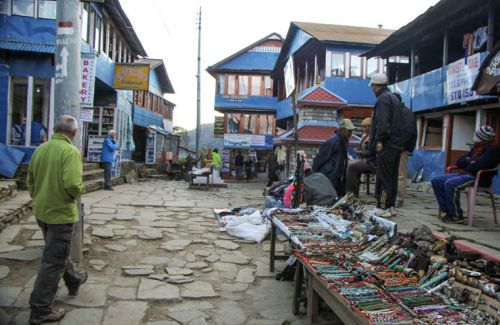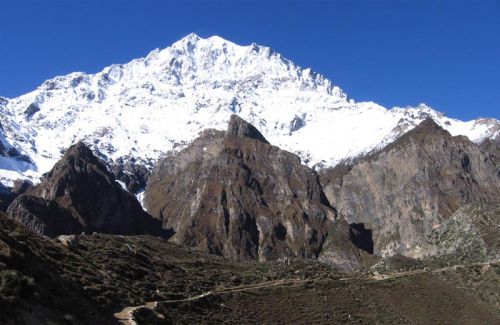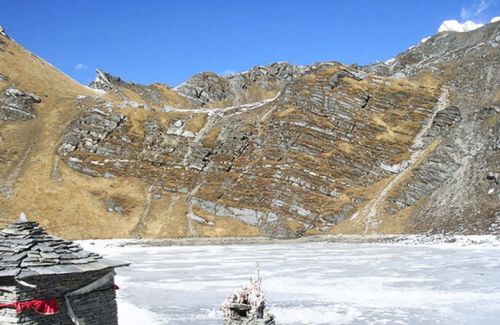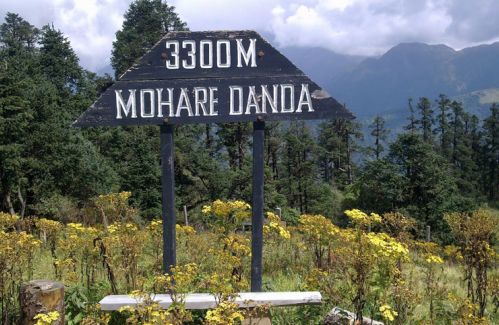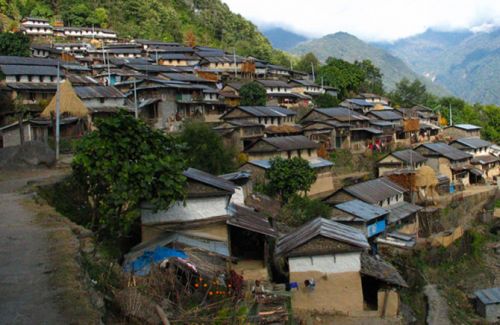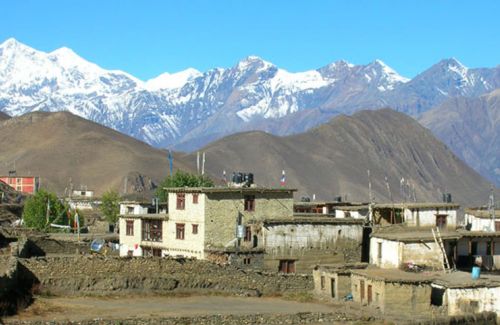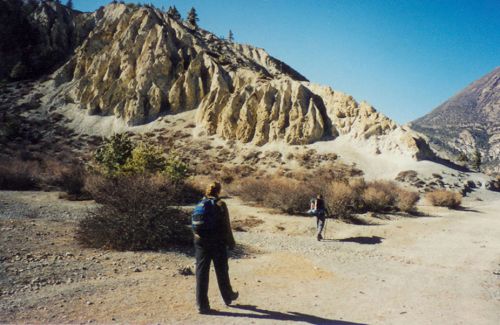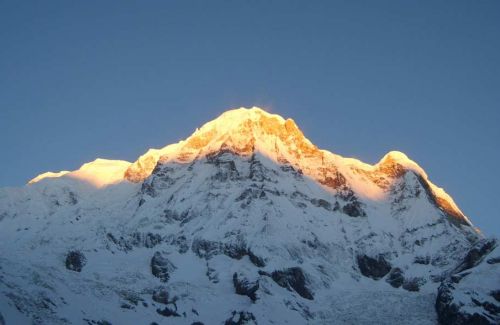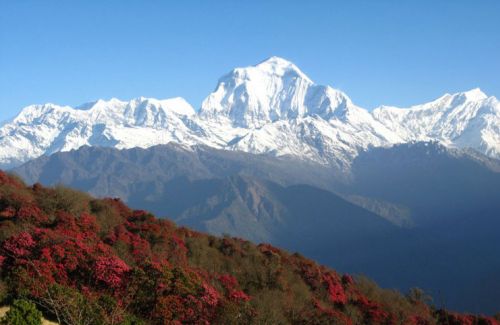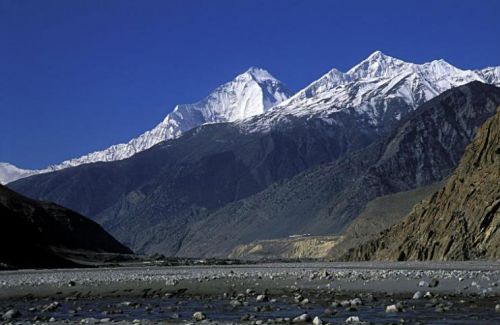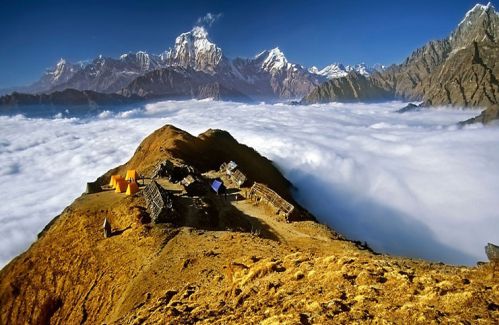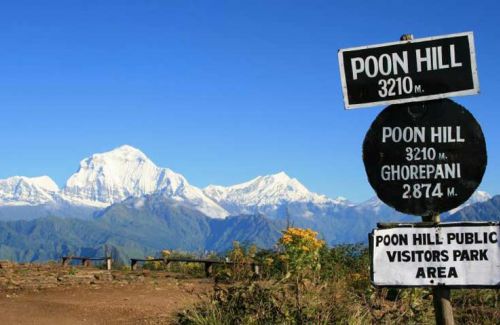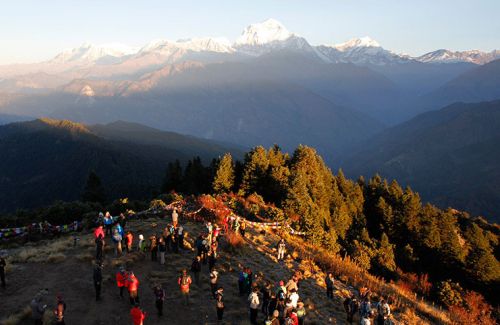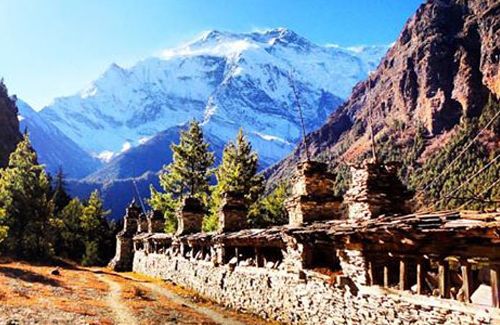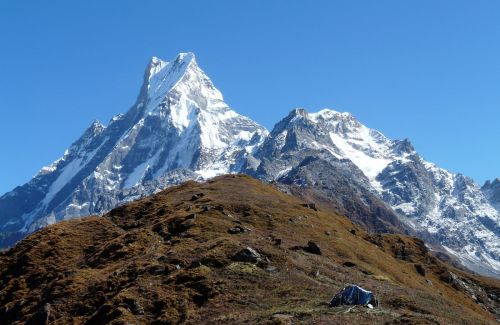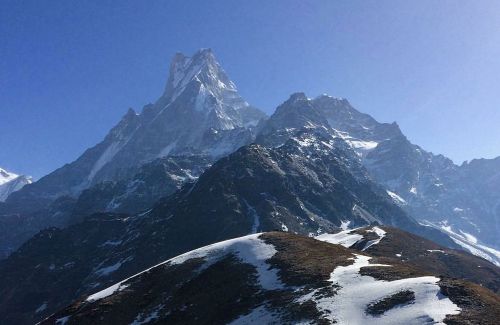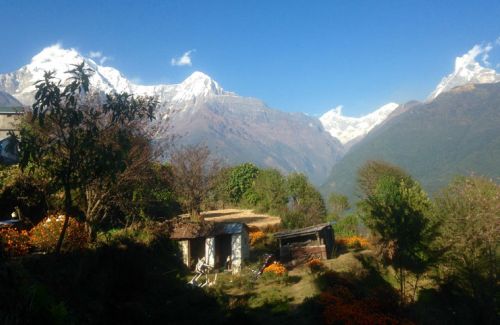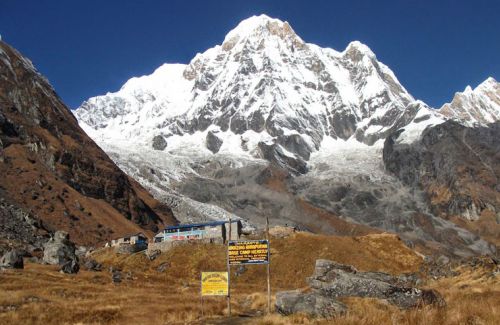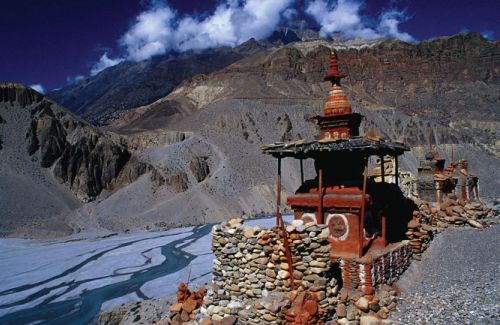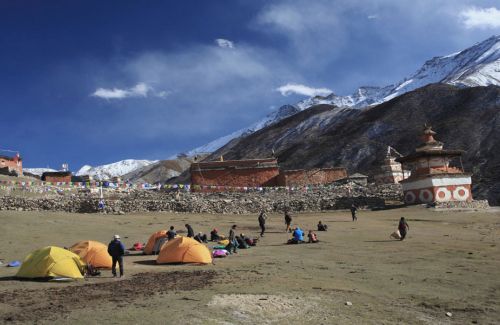Annapurna Circuit Trekking
- Duration21 Days
- Max. Altitude5,416 m.
- Starts FromUSD 1520
Destination:Nepal
Trip Grade:Strenuous (****)
Meals:Breakfast + Lunch + Dinner
Transportation:Private Vehicle/Tourist Bus
Accommodation:Lodge
Best Season:September to December & February to May
Show AllThe Annapurna circuit trekking is a challenging but rewarding three weeks trek with the fabulous mountain views, plenty of cultural contact in rural community and friendly villages in the lower realms of the Annapurna Conservation Area. We can meet more than ten different culturally rich ethnic groups that reside in different climate zones of Annapurna Circuit.
Since Annapurna Circuit Trek opened to foreign trekkers in 1977, the trek around Annapurna has become the most popular in Nepal. We cross four districts Lamjung, Manang, Mustang and Myagdi while doing this trek. Trek Annapurna Circuit is to go around Annapurna massif starting in subtropical paddy field at about 500 m to the 5,416 m Thorong La Pass. The circuit is usually walked counter clockwise due to the steepness of the track to the Thorong La. For many people, this is too much to manage in one day. The Thorong La is often closed due to snow from Mid- December to Mid – March. The trail in Thorong La can be hard to find when covered in snow.
It is good to stay few extra days for digressions, acclimatization and other contingencies. The trek is strenuous so that you need to have proper trekking gear.The usual starting point is Dumre, leads to Beshishahar. The route follows the Marshayangdi Valley north and west all the way to the pass, the walk from Chame to Manang is spectacular : the sight of the huge glacier - dolloped Annapurna towering above the valley,seems fascinating. Manang is the town where the Managis, the Bhotiya clan has settled. The Gumbas at Manang and Braga are well worth visiting. There is a Himalayan Rescue Association Post in Manang. Climbing Thorong La and descending down to Muktinath from the other side is tough but exhilarating. Then, we can follow the Jomsom trek route.
Trip Highlights
- Sightseeing in World Heritage Sites in Kathmandu
- Scenic drive through countryside from Kathmandu to Beshishahar
- Amazing scenic landscape of Annapurna Circuit
- Great Mountain View from Manang, Thorong-La and Poon Hill
- Crossing over the Thorong La Pass (5416 m)
- Explore Manang and be familiar with their culture
- Walking through the deepest gorge of the world-KaliGandaki Valley
- Enjoy hot shower at Tatopani
- Visit Muktinath, the great pilgrimage site for duo HIndus and Buddhists
- Experience the many ethnic groups ways of living, and their tradition
Day to Day Itinerary
Day 01: Arrival in Kathmandu (1,350 m) and Transfer to the Hotel
Day 02: Sightseeing around Kathmandu valley & Trek Preparation. O/N at Hotel
Day 03:Drive from Kathmandu to Besishahar (823 m), 6 hrs. O/N at Hotel
Day 04:Trek from Besishahar to Bahundanda (1,430 m), 6 hrs. O/N at Guest House
Day 05:Trek from Bahundanda to Chamje (1,560 m), 6 hrs. O/N at Guest House
Day 06:Trek from Chamje to Dharapani (1,881 m), 6 hrs. O/N at Guest House
Day 07:Trek from Dharapani to Chame (2,725 m), 5 hrs. O/N at Guest House
Day 08:Trek from Chame to Pisang (3,100 m), 6 hrs. O/N at Guest House
Day 09:Trek from Pisang to Manang (3,500 m), 4 hrs. O/N at Guest House
Day 10:Acclimatization day at Manang
Day 11: Trek from Manang to Yak Kharka (4,090 m), 5 hrs. O/N at Guest House
Day 12:Trek from Yak Kharka to Thorang Phedi (4,420 m), 4 hrs, O/N at Guest House
Day 13:Thorang Phedi to Thorong-La (Cross over 5,416 m), then trek down to Muktinath (3,802 m), 8 hrs. O/N at Guest House
Day 14:Trek from Muktinath to Marpha (2,670 m), via Kagbeni - Jomsom, 6 hrs. O/N at Guest House
Day 15:Trek from Marpha to Kalopani (2,480 m), 6 hrs. O/N at Guest House
Day 16:Trek from Kalopani to Tatopani (1,219 m), 6 hrs. O/N at Guest House
Day 17:Trek from Tatopani to Ghorepani (2,860 m), 7 hrs. O/N at Guest House
Day 18:Trek from Ghorepani to Ghandruk (1,951 m), 4 hrs. O/N at Guest House
Day 19:Trek from Ghandruk to Nayapul (1,070 m), 4 hrs, then 1 hour drive to Pokhara (827 m). O/N at Hotel
Day 20:Drive from Pokhara to Kathmandu (1,350 m), 7 hrs. O/N at Hotel
Day 21:Transfer to international airport
Cost Include
- Airport Picks up and Drops off by tourist vehicle
- Guided City Tour by private tourist vehicle
- Government License holder city tour guide
- Hotel in Kathmandu (3 nights twin sharing) & Pokhara (1 night) with Breakfast (Hotel Category as per your choice)
- Full Board meal during the trek
- Tea House,Guest Houses Accommodation during the trek
- Annapurna Conservation Area Entry permit
- TIMS (Trekker’s Information Management System) Fee
- Experienced English Speaking Trekking Guide
- Local Trekking Porters (2 Trekkers = 1 porter)
- Food, Salary, Accommodation and Insurance of Guide and Porters
- Down Jacket, Duffel Bag and Sleeping Bag by Himkala Adventure if required
- Drive from Kathmandu to Beshishahar by Local Bus
- Drive from Pokhara to Kathmandu by Tourist Coach
- All necessary government tax, VAT, and service charges
- Dinner after completion of your trek with Nepalese cultural show
Cost Exclude
- Lunch and Dinner in Kathmandu and in Pokhara
- All Entrance Fees in the monuments
- Personal Expenses ( Phone Bills, Bottled or Boiled water, Bar, Laundry, Shower etc.)
- Nepal Entry Visa Fee
- Your Travel Insurance
- Emergency Rescue Evacuation
- Tips to the trekking, tour staffs and driver (Tipping is expected)
- Any other expenses that has not been mentioned in the Cost Includes Section
Detail Itinerary
Day 01 Arrival in Kathmandu (1,350 m) and Transfer to the HotelUpon your arrival at Tribhuvan International Airport, our representative from Himkala Adventure greets you and transfers you to the hotel. You can get refreshed with hot shower and invigorate yourself from the jet lag after long flight.You could walk around the local market. Overnight at Kathmandu
Day 02 Sightseeing around Kathmandu valley & Trek Preparation. O/N at Hotel After breakfast, we leave hotel at 9 am for the city tour. We visit Swoyambhu Stupa, known as monkey temple and view the four main hills surrounded Kathmandu valley and the town from the top if it is clear then proceed to Kathmandu Durbar Square, see the living goddess, palace, courtyards and head towards Boudhanath. The place is influenced by Tibetans as there are many Tibetans monk walk around and after a kilometer, we visit the Hindu temple of Shiva, where there is a cremation spot. We drive back to hotel and give you briefing about the Annapurna Circuit trekking. Overnight at Kathmandu
Day 03Drive from Kathmandu to Besishahar (823 m), 6 hrs. O/N at Hotel After breakfast, we drive to Beshishahar viewing picturesque village houses, terraced fields, following rivers, we reach about 137 km to Dumre, and the road splits and goes to the right to Beshishahar, at an elevation of 823 m. Overnight at Beshishahar
Day 04Trek from Besishahar to Bahundanda (1,430 m), 6 hrs. O/N at Guest House After having breakfast, we drive to Khudi (830 m) along the rough road. This is the first Gurung village we visit in this trek. The Khudi trail offers fine views of Himalchuli, Manaslu II, as it climbs to Bhulbule (840 m). We have to show our permit here and should register here as we are entering to Annapurna Conservation Area from here. The trail continues on to Ngadi before reaching Lampata (1,135 m) and then Baundanda. There are few shops, many hotels. Overnight at Bahundanda
Day 05Trek from Bahundanda to Chamje (1,560 m), 6 hrs. O/N at Guest House From Bahundanda, the trail crashes down steeply to Lili Bhir, and then follows an open trail. The nice waterfall can be seen in Ghermu Phant. From Syange, we cross to the west bank of the Marshyangdi Khola through the suspension bridge. The trail traverses through the river and reaches to Jagat. This is the steep sided valley. he path descend before climbing through the forest to Chamje. Overnight at Chamje
Day 06Trek from Chamje to Dharapani (1,881 m), 6 hrs. O/N at Guest House After breakfast,we start our trek to Dharapani. We descend for less than ten minutes and cross to the east bank of the Marshyangdi Khola on a suspension bridge (1,440 m). Viewing the oak forest, we continue the upstream, reach to the gorge where there is an old landslide from the mountain, and enter to the pleasant, flat valley called Tal (1,700 m). The way to Manang crosses the small tributary beyond Tal on a log bridge upstream in the valley that again narrows. After this, we pass an old suspension bridge and continue upstream on the east bank, cross another new bridge over the Marshyangdi Khola (1,905 m) to the west bank and reach Dharapani, Overnight at Dharapani
Day 07Trek from Dharapani to Chame (2,725 m), 5 hrs. O/N at Guest House From Dharapani, we continue on upstream and the valley comes down from the Larkya Pass. The village of Thunje lies on the congfluence of Dudh Khola and Budhi Gandaki. Thonje in Gurung language means “Pine trees growing on a flat place”. A pleasant half an hour’s walk brings us to the Bagachhap (2,164 m).The small gumba built by Nyingmapa sect with its beautiful frescoes in the wall is interesting there. The views of Annapurnas and the part of Lamjung Himal is remarkable. The trail often rough and rocky, climbs over a ridge through Timung and continues through the forest of pine and fir to Kotho (2,640 m). The prominent tributary valley heading north is the Nar Khola, which drains the region called Nar Phu. The inhabitants are traditionally pastoralists.After crossing other tributaries; we enter to Chame, the headquarters of Manang. Overnight at Chame
Day 08Trek from Chame to Pisang (3,100 m), 6 hrs. O/N at Guest House From Chame, first we cross the tributary from the south then the Marshyangdi Khola. We continue the pleasant trail to reach to Taleku (2,804 m). So the trail runs, through deep forest in a steep and narrow valley and recrosses the Marshyangdi Khola. The former Khampa settlement of Bhratang is just beyond. The view of Paungda Danda rock soaring up high is an incredible. So, if we keep close to the river,we come to lower Pisang, and if we ascend to the north side of the valley we reach to Upper Pisang. But we remain in Lower Pisang. Overnight at Pisang
Day 09Trek from Pisang to Manang (3,500 m), 4 hrs. O/N at Guest House From Lower Pisang, it is easy to take lower direct route. We cross the Marshayangdi Khola to its south bank at lower Pisang, cross the tributary and ascend to the pine and juniper forests. We reach to Ongre (3,322 m) after crossing the upper valley floor. The trail then ascends to the north bank to a small town, Munchi (3482 m). After Munchi, we climb up to Gyaru (3,673 m), then after 45 minutes to Ngawal (3,650 m) and reach to Braga (3,505 m). Braga is the large and interesting village, the seat of the oldest monastery in the area.The gompa is of Kargyupa sect of Tibetan Buddhism.The village of Manang is half an hour from Braga. After heading up the valley to the ridge crest, we reach at Manang, spectacularly perched. Overnight at Manang
Day 10Acclimatization day at Manang It is an important to acclimatize before you challenge to Thorung La.We can go for the side trips and gain some altitude during the day. The village of Khangsar, the way to Tilicho Lake and around it offer wonderful Himalayan setting. Manag is the trading center and they are rich in their cultural activities. Perhaps, we may see an archery or a horse race! Overnight at Manang
Day 11 Trek from Manang to Yak Kharka (4,090 m), 5 hrs. O/N at Guest House When the day light breaks, the Mountain View seems unbelievable from Manang. After leaving Manang through old city, we come to the stupa from where we can see the hypnotic view of Gangapurna Lake. There is a confluence of Marshyangdi (Khangsar Khola) and from the left and the Jharsang Khola from the right near to Tengi. We follow the Jharsang Khola to Yak Kharka. The mysterious view of Annapurna II,IV, III, and Gangapurna can be seen throughout the hilke to Yak Kharka.We stop at Gunsang for the lunch and head towards to Yak Kharka.Yak Kharka is at an elevation of 13,185 ft., a small settlement hemmed in both sides tightly by steep hills. It has few lodges and tea houses. Overnight at Yak Kharka
Day 12Trek from Yak Kharka to Thorang Phedi (4,420 m), 4 hrs, O/N at Guest House The trail gently rises from Yak Kharka to Thorong Khola valley up to the Base Camp in Thorong Phedi. Every morning, the trekkers set off to Thorong La Pass. We cross the bridge and go through right hand side. The old path from left hand side has been destroyed; even the new path also has been threatened. After a while we ascend the constricted valley and reach to Thorong Phedi. If we are not tired, we can go to hike up to the Base Camp. Overnight at Thorong Phedi
Day 13Thorang Phedi to Thorong-La (Cross over 5,416 m), then trek down to Muktinath (3,802 m), 8 hrs. O/N at Guest House We get up early in the morning and set out for the trek to Thorong La Pass.From Phedi, we ascend to a notch (4,793 m) and head left to the west, traversing to the base of a prominent lateral moraine (4,846 m). Then we reach its crest (4,852 m) later and continue the steep terrain and reach to the Thorong La Pass. To escape from the bad weather and windy afternoon, we cautiously cross over 5,416 m in 4 hours. We pass many chortens and colorful prayer flags on the way. The view from the top is not enough to describe by words and pictures. This beauty elevates our soul. We feel inexpressible inner joy.
This is another 4 hours trek descending down to the sacred Hindu-Buddhist pilgrimage site.It becomes considerably steeper and keeps to the south side of the valley on scree. Muktinath means the lord of salvation. The temple is dedicated to Lord Vishnu. There are 108 holy water taps and an eternal flame fed by natural underground gas. Overnight at Muktinath
Day 14Trek from Muktinath to Marpha (2,670 m), via Kagbeni - Jomsom, 6 hrs. O/N at Guest House After breakfast, we follow the trail that goes from the Kali Gandaki. This is famous for the ammonite fossils, known as Shaligram. These black stones are worshipped by the Hindus as an incarnation of Vishnu. This is how we can view the arid landscapes in the north and snowy mountains in the south. We come to Kagbeni via Jharkot and to Jomsom. After one and half hours walk from Jomsom, we reach to Marpha. It is a charismatic town, famous for apple. People dwelling there call themselves Paanchgaule, ethnically similar to Thakali. Overnight at Marpha
Day 15Trek from Marpha to Kalopani (2,480 m), 6 hrs. O/N at Guest House The trek from Marpha to Kalopani is about 6 hours. From Marpha, we trek down to Thakali village,which was once the trading center. After this, we reach to Tukche (2,591 m), a historically important town. After an hour later we arrive at Khobang. The scenery becomes sharper with the greenery and due to juniper and pine forests and reach to Larjung. It takes 2 hours from Larjung to Kalopani. Kalopani is the ideal place for the sunset view. Overnight at Kalopani
Day 16Trek from Kalopani to Tatopani (1,219 m), 6 hrs. O/N at Guest House After breakfast, we leave Kalopani and walk through the road. After the village, we turn left into the forests. After the forests, the landscape can be seen to grassy fields with dry stone walls. After an hour, we reach the village of Ghasa where the permit is checked at the end of the village. We walk down, cross the bridge and walk along the path beside the river. We reach to the gorge, steady downfall walk with steeps. We walk from the green and rocky path and arrive at the bottom of the deep vally. After a while, we reach to Tatopani. Overnight at Tatopani
Day 17Trek from Tatopani to Ghorepani (2,860 m), 7 hrs. O/N at Guest House After the day break, the sun’s tender rays over the Nilgiri seem of exotic beauty. We leave Tatopani and head up the Ghar Khola valley.The trail leads through a terraced farmland. The mountains around is just fascinating and memorable.We pass through the Shikha and Chitre. The rhododendron forest before Timang is eye-catching. After this, we reach to the ridge of Ghorepani. The Poonhill hike is still left to be done in the next morning. Overnight at Ghorepani
Day 18Trek from Ghorepani to Ghandruk (1,951 m), 4 hrs. O/N at Guest House We hike to Poon hill early in the morning which takes an hour to reach Poon hill. The great mountain scene extending from Dhaulagiri to Annapurnas is amazing. After we return back to hotel, we get breakfast and head towards Ghandruk. The trail descends steeply through the forests to Bhaisi Kharka. We take the right hand trail, drops down to the stream and goes out on a ridge towards Ghandruk. Ghandruk is the famous Gurung settlement. Overnight at Ghandruk
Day 19Trek from Ghandruk to Nayapul (1,070 m), 4 hrs, then 1 hour drive to Pokhara (827 m). O/N at Hotel After breakfast at Ghandruk, we follow the main trail that goes to the southdescending through the stone steeps and passing high above the river with stone paved trail. We cross a stream at Chane (1,690 m), continue to Kimche (1,640 m) and follow the ridge downhill to join the Modi Khola at Syauli Bazaar (1,140 m). From here, we go through the flat trail, following the river valley, passing terraced land and birch forest and reach to Birethanti. After 30 minutes walk from Birethanti, through the rough road, we reach to Nayapul. It is an hour drive to Pokhara. We can explore the city in our spare time. Overnight at Pokhara
Day 20Drive from Pokhara to Kathmandu (1,350 m), 7 hrs. O/N at Hotel It is 200 km from Pokhara to Kathmandu and takes about 6-7 hours by bus. You won’t regret drive to Kathmandu because the road is smooth and the scenery through the villages and local markets, viewing the peasants working in the terraced fields, and the road passing through the Mahabharat hills following the riverside gives you immeasurable lifetime experience. Himkala Adventure takes you to the dinner with typical Nepalese Cultural Show and come back to hotel Overnight at Kathmandu
Day 21Transfer to international airport As per your flight schedule, we escort you to the Tribhuvan International Airport 3 hours prior to your flight. We, with warm greeting depart you on the airport for your onward destination. We wish you for your safe journey. Namaste with palms together!!!
Trip FAQ
Himkala Adventure would like to quench the thirst of all necessary questions answers about Annapurna Circuit Trekking for all curious travelers/trekkers in the world. As you are entirely from different geographical location, you could better to know everything about the treks from the beginning i.e. airport pick up till your departure like airport picks up, drops off, accommodation in city, in the trek, guide and porters, safety for the trekking, food and accommodation and some other things that you might face on the way. Hope our endeavor listing these questions answers will help you self informed.
This is simply the outlines of the services we offer but it may differ as per your requirement, number of trekkers. What we go through our conversation, we will manage the means of transportation, hotels in the city, accommodation in the trekking, numbers of porters etc. This is general idea about Annapurna Circuit Trekking before your trip and you become clearer about the trek. Please feel free to contact us to get more information about the trekking in the Himalayas of Nepal.
1) How is Annapurna Circuit Trekking in Nepal?
Annapurna Circuit trekking is the popular trekking trail of Annapurna Region in the western part of Nepal. Annapurna Circuit Trekking is the strenous trek that goes through the Thorung La Pass, at an elevation of 5,416 m and touches the Tibetan plateau.Practically all trekkers hike the route counter clockwise, as then the daily altitude gain is slower and crossing the high Thorong La pass is easier and safer.The trail passes along paddy fields and into subtropical forests, several waterfalls and gigantic cliffs, and various villages. Annapurna Circuit has often been voted as the best long distance trek in the world, as it combined, in its old full form, a wide variety of climate zones from tropics at 600 m asl to the arctic at 5416 m asl at the Thorong La pass and cultural variety from Hindu villages at the low foothills to the Tibetan culture of Manang Valley and lower Mustang.
2) What physical fitness do I need to book this trip?
Every trekking in the Himalayas of Nepal require the certain level of physical and mental fitness.So, we advise you to be in good physical shape and able to feel comfortable while hiking up and down 7 to 12 miles per day on a trail carrying a day pack of about 10 pounds. Three things could make you confident enough for any trek you would like to do: aerobic, strength and mental.
Aerobic conditioning is important primarily because you will be trekking in thinner air, up to 40% less than at sea level. With good aerobic conditioning, you will be able to better metabolize whatever oxygen is available to you. You should plan on doing at least one hour of aerobic 3 /4 times per week for 1 month or more before your arrival in Nepal. Walking, jogging, cycling, hiking on valley floor to ridge line ascents with day back are some of the excellent forms of exercise, so long as you are strengthening leg muscles and building stamina. Speed is not the essence; stamina, confidence and continuity are.
3) How do I find Himkala Adventure for my pick up at the airport?
Our representative from Himkala Adventure will display a small board of company or your name on the sheet of paper outside the airport terminal. You will be driven to the hotel by our tourist vehicle.
4) What sort of accommodation do I get in Kathmandu,Pokhara and Beshishahar?
Normally we provide standard rooms with twin sharing accommodations at three star or similar category hotels in Kathmandu and Pokhara including breakfast. Accommodation in these cities can be upgraded as per your request. But some of our packages are sold without accommodation in the city. The accommodation in Beshishahar is good as of Guest House standard.
5) How are tea house facilities during Annapurna Circuit Trekking?
Tea House is the combination of guest house, restaurant, and social hang out. Tea houses in Mini Annapurna Circuit trekking area are highly professional though they are simple but with neat and clean lodging offering fine views and plain but fresh and hygienic food with friendly atmosphere Most of the Tea Houses have running water facility. Many of them have hot water available for bathing. But we discourage our groups from using water heated by wood as lack of firewood in most villages is a big environmental concern in Nepal.
6) What sort of accommodation do I get in trekking?
Guesthouses/Tea Houses/Lodges provide twin sharing single and double rooms and occasionally a dormitory which is basically clean with a mattress and a quilt or blanket. Our company provides the sleeping bag if needed but we always recommend having your own sleeping equipments. You have to share the room with your group member or sometimes with unknown traveler. The toilet is always outside the room with basic facilities.
7) What sort of foods, water and drinks can I expect in trekking?
The foods in the Himalayas are very simple. There are mostly the family members themselves to cook and serve the meal. They are simply trained but experienced because they have been offering such services for many years in this busy route. The food is hygienic, fresh and delicious. We recommend you to drink mineral water or the boiled or using water purification pills or drops.
Most of the foods are cooked in the kitchen of tea houses. They serve you with different varieties of delicious Nepali and continental dishes. The most popular Nepali food is daal bhat (rice and lentils) with some mixed vegetable curry. Garlic soup is popular as it helps you with acclimatization. You could better be vegetarian in the mountains. All hotels in cities and guesthouses in trekking serve the vegetarian food. You can find all common types of drinks like hot chocolates, coffee, tea, hot lemon with honey, ginger tea, soft drinks etc. you will have your breakfast and dinner at the lodges where you will be staying and lunch somewhere on the way to your next destination.
8) What mode of transportation do I use?
We will provide the private transportation for Airport/Hotel/Airport pick up and drop and sightseeing in Kathmandu Valley. We use transportation as based on our cost inclusion section. The transportation varies depending on your requirements at the time of booking the trip.
9) What is the best season for this trekking?
The best season for Anapurna Circuit Trekking is spring (March to May) and autumn (September to December). These are the perfect time of the year for the breathtaking views of Himalayas with clear and sunny days. But the weather in the mountains is unpredictable.
10) What is the weather and temperature like during the trekking?
The climate in Nepal varies from place to place which can be categorized in different four main seasons. The main seasons in Nepal are spring (March to May), summer (June to August), autumn (September to November) & winter (December to February). The best season to travel in Nepal is autumn (September, October & November) & spring (March, April & May). Weather in the mountains is unpredictable. But the day temperature in the Annapurna Circuit Trekking is comfortable.
11) Who will be guiding me during this trip?
We provide the professional government license holder English speaking trekking guides for our entire trekking trip. We can also provide French, Spanish, Japanese, German or Italian speaking guides as per your preference with extra payment but not guaranteed. All guides will be Nepali people who are carefully selected on the basis of their appropriate experience, leadership skills and personality. They are all trained from Nepal Academy of Tourism and Hotel Management, certified and approved by the Tourism Department of Nepal government. We provide a different city tour guide to guide you in UNESCO World Heritage Sites in Kathmandu. They are the professional license holder guide specialized in culture, history, geography, iconography, archeology and religion with good command over English. Tour guides are specialized in city tour and trekking guides are more in the hiking and trekking in the Himalayas.
12) What sort of experience do your guides have?
Our entire city tour guides have bachelors to Master Degree academic education along with many months tour guiding training from Nepal Academy of Tourism and Hotel Management, Rabi Bhawan, Kathmandu, Nepal. They are fluent in spoken languages and informative about the sites in many aspects. They are quite experienced and dedicated to their job and responsibilities.
Our entire trekking guides have minimum Intermediate to Master Degree academic education with trekking guide training from Nepal Academy of Tourism and Hotel Management, Rabi Bhawan, Kathmandu, Nepal. Many of them are from villages. As they are local, they know more about the routes, necessary precaution to be taken and so on. They have spent many years exploring many parts of the country. They are trained in first aid and able to handle any situation easily. They speak good English and make you know about the places you visit.
13) May I charge my electronic gadgets during Annapurna Circuit Trekking?
Most of the places in your tea houses have charging facilities. You can charge your devices by paying some extra money. It’s good if you bring TWO or THREE pin travel adapter and put your gadgets at warm place at night.
14) How much additional money is required for this trip?
It’s a very personal question as expenses depend on habit. Normally, in Kathmandu you can allocate about USD 10 to 15 per person per lunch or dinner. USD 10 to USD 15 per person per day will be sufficient to buy bottles of water, chocolates, pay for a hot shower during the trekking. Other personal expenses will be your own calculation.
15) What is the social and environmental responsibility of Himkala Adventure for this trip?
The situation of environment in Nepal is in considerable stage due to so many factors caused by global warming, human activities, and adverse effects of natural incidents. Nepal is in between two giant countries like China and Nepal. The ozone layer is depleting and the atmosphere is getting heated. So, its direct effect is to the Himalayas that the snow is melting day by day and the sea level is rising. It is due to population growth, people are clearing the forest and the soil is being eroded. As a part of society, and our trekking related activities are directly concerned with the social and environmental things. We are very conscious not litter in the open spaces, to manage garbage properly and make local people aware in this campaign. We are working together with other companies and taking these issues seriously.
16) What is the minimum number requirement for this trip?
We operate individual trip to the group joining trips for Annapurna Circuit Trekking. If you want to do any private trip we are ready to organize for solo traveler as well with some additional charges.
17) Are there communication or internet services during Annapurna Circuit Trekking?
All guesthouses/lodges in Annapurna Circuit Trekking trails have telephones and internet services. They provide the WIFI service with some extra charge which helps to get updated with social Medias, friends or family. All our guides carry the local mobile phone. You can use his mobile phone to make any local or international call from trekking trails by paying him directly. You can even pass him number to be connected with your family or friends. We highly recommend taking local SIM card for call and internet services during trekking. Local SIM cards are easily available in many stores and at airport as well. You need to provide two copies of your photographs and your passport copy to get local SIM CARDS of NCELL & NTC (only these two companies provide telephone services in Nepal
18) May I get chances for shower during Anapurna Circuit Trekking?
Most of the guesthouse provides hot shower with some extra cost. In few places, bucket water will be provided for the shower.
19) May I add extra days in trekking?
We are ready to operate your holidays as per your interest and requirements. You can spend extra days on your loving or favorable places or even can make it shorter. We will always do our best to manage your hotel bookings, flight booking and everything.
20) What happens in case of emergency?
Himkala Adventure has prepared for any emergency situation and knows how to handle it. Our guides are trained in first aid and can deal with most of the basic ailments that occur during the trek. Every client should have his own insurance before coming to Nepal for the case of emergency.
21) Do I need to have insurance for this trip?
We request you to have a travel-insurance policy to cover theft, loss, medical problem & emergency helicopter evacuation from high altitude places before coming Nepal. Choose a policy to cover your emergency high altitude helicopter evacuation with all medical insurances for trekking in high altitude in the Himalayas of Nepal. Your travel insurance is always needed before going in any high altitude trekking. Please check your travel insurance policy which doesn’t exclude mountaineering or alpinism. Although you will not be engaging in these activities in your trekking, you might have problem convincing the insurance company of this fact. Rescue insurance need to cover an emergency helicopter evacuation or a charted flight from remote mountain trails of Nepal as well as international medical evacuation. A helicopter evacuation might cost US$ 2500 to US$10000 depending on the places. So that travel insurance to cover all above is must to travel in the high Himalayas of Nepal.
22) What is the baggage allowance from/to Kathmandu – Pokhara flight?
One can fly from Kathmandu to Pokhara. It is scenic flight over the mountains which takes 25 minutes.Normally, it is 20 kg free allowed per head flying from/to Kathmandu – Pokhara flight. If we have bought tickets in a group then it calculates member and multiply 20 X ..., rest we need to pay approximately USD 1 per Kg.
23) What type of shoes should I wear during Annapurna Circuit Trekking?
You could better have carefully chosen hiking boots which should be kind of strong, well-made but light boots for Annapurna Circuit Trekking. Shoes and boots are best to buy before arriving in Nepal. We advise you to wear your new shoes for sometime before trek so that you could feel well habituated on the newer trail for your feet.
24) Can I use credit cards in the Annapurna Circuit Trekking route?
Of course not, you can use only in the cities like Kathmandu, Pokhara but not in the Annapurna Circuit Trekking route. When you are out of city, all you need is cash, better to have small notes. Please change the currency in local Nepali rupees before you go to the mountains.
25) Do I need to tip my guide and porter? How much would that be?
Tipping is not mandatory, neither it is right to ask by anyone but it is a way of showing gratitude after taking service. The level of tip also shows how satisfy you are from the team that you had been during your tour/trek.However, we recommend you to spend minimum 10% of your total trip cost for tipping entire local staffs, the ratio of tipping guide and porter will be given to you at the pre-trip meeting in Kathmandu before starting the trek.
Trip Note
Cost:
The cost of trip varies according to the number of travelers in the group, the category of the Hotel, mode of the transportation and any kind of changes (if there is). So, if you would let us know all of these above mentioned things, then we could quote you the exact price.
Walking Trails:
There are stone steps up and down in most of the trekking routes in Annapurna Region. So, you might find a pair of trekking poles very useful.
Weather:
The main trekking season in Nepal is from October to December and March to May. The day temperature for walking in Annapurna region is comfortable. The sky is clear although there is snow and rainfall occasionally. It is about 10 degree centigrade at the height of 3,600 m and increasingly lower, the higher we go. There may be snow at Annapurna Base Camp at any time of the year.
Nepal Strikes:
There is much more progress in the political scenario in Nepal and we assure you that travelling in Nepal is safe. But there may be Bandha (wide transport strikes) at a very short notice. The shuttle bus is in operation by Nepal Tourism Board and the Nepal Tourist Police in conjunction with the Himalayan Rescue Association from domestic and international terminal to the various hotels in Kathmandu. The service costs 300 rupees per person.
Itinerary Disclaimer:
Himkala has thoughtfully designed all the itineraries but our itineraries are updated for the betterment on the basis of our past travelers’ comments and our own research. In case you find changes in the itinerary you printed and the upgraded one does not affect your trip. Please note that some changes may occur in our itineraries due to bad weather and common seasonal changes to timetables and transport routes.
Physical Rating:
Your trip will be meaningful if you could find yourself fit and fine. You will be walking up to 5,416 m from the sea level. As the geographical region varies, there is a temperature variation as well. So, we advise you to undertake regular physical exercise, jogging, hiking, riding, ascending and descending the long stairs etc.Precautions and acclimatization are undertaken but be aware of the effects altitudes can have.
Group Size:
Himkala Adventure organizes solo to group travelers. Our group trips are designed for sharing accommodation and there is no single supplement. Single travelers share with the same gender from twin to multi-share in an accommodation. You are requested to have mutual understanding in between the fellow travelers who have joined from the different parts of the world. Please remember that you have great responsibilities in the group. If you are requested to be at a particular place at a certain time, make sure that you have been there at a time. It is much more pleasing sharing experiences and traveling together.
Accommodation and Meals:
Accommodation and Foods in the Himalayan region of Nepal cannot be compared with any developed countries in the world. We know that you might not have experienced such things before but you should take it easy. Accommodations at local lodges are simple but clean and comfortable. The food is plain. Toilets and washing facilities are shared and rudimentary. In high altitude regions, there are very few tea houses and one has to be happy to share in simple dormitories without electricity, without running water. Hot shower means a bucket of hot water upon our request.
Money Matters:
Please note that most establishments in Asia will not accept foreign currency notes that are old, torn or faded and they can be very difficult to exchange or extra fees added when exchanging at banks. Please ensure that you have new, clean notes.
The official currency of Nepal is the Nepali Rupee (NPR). ATMs can be found only in major cities of Nepal like Kathmandu, Pokhara, Chitwan, Bhaktapur etc. The government of Nepal has banned the import, export and use of 500 and 1000 Indian rupee notes in Nepal. You make sure that you won’t carry these notes upon arrival in Nepal, otherwise they are confiscated and you may be fined.
Please make sure that the foreign currency notes that you have are new and clean notes because old, torn or faded foreign currency notes in Nepal are very difficult to exchange or extra fees added when exchanging at banks.
While travelers cheques have security advantages exchanging them can be a lengthy process, commissions can be high (up to 10%) and they can be difficult to change in rural areas, on weekends and public holidays. If you choose to bring travelers’ cheques, make sure they are a major brand and major currency.
Tipping:
Tipping is not mandatory. It is not anyone’s right asking for tips but if you are happy with the service, you could tip the staffs. It is entirely a personal preference. Tipping could be significant to them who took take great care of you in your traveling period. Himkala recommends that you could tip any intended recipient by any member of the group than collected and passed on by the group leader.
Note: Please do not tip with coins or dirty and ripped notes. This is culturally taken as an insult.
Local Dress in Nepal:
Nudity is a sensitive issue in Nepal. Women should avoid wearing shorts and sleeveless tops in public places where this might be seen as inappropriate. Remove shoes before entering certain holy places. Non-Hindus are not permitted in some temples.
Feedback:
Your feedback will be the great guidance to meet our target and to bring improvement in our service. What and how have you experienced with Himkala Adventure and our staff? Please write, we will read it carefully. One cannot see his/her shortcomings that are lying with them. Someone should point it out. We are always eager to hear from you.
Trip Info
- Washing and Shower
- Water/Food and Nutrition
- Trip Grading
- Weather
- Accommodation/Shelter
- Altitude Sickness
- Communications and Updates
- Conservation
- Cross Cultural Issues
- Essential Do’s and Don’ts
- Foot Ware/Foot Care
- Health and Fitness
- Himkala Crews
- Hypothermia
- Safety and Security
- Travel Insurance and Evacuation
- Trip FAQs
- Equipment List
